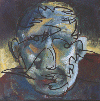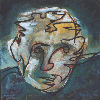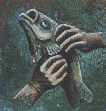

both oil on MDF board h57.5 x b77.5cm,
January 2000
 |  |
"Self-portrait no.1",
"Self-portrait no.2"
both oil on MDF board h57.5 x b77.5cm, January 2000 |
So many artists have made self-portraits, so why not me too? I chose to do
two portraits: the basic idea was to do a blue head over a yellow
background and a yellow head over a blue background. I decided to do a few
things I had done before and try a bit more. I chose for the vertical
drapes (see
"Sic Transit Gloria Mundi" 1997),
for the background, and I also applied masking tape at random when painting
my own face, so that the background would be revealed though my face once
the masking tape was pealed off again. Before I painted my face, I made a
broad frame for the MDF board, so that I could paint part of the frame too.
I did various "frustrated" drawings (see
"Et Tu Brute?" 1998)
of my face and copied them onto the rough patches of paint already there. In
"Silence of the Hams" (1998)
the complete frame belongs to the picture, but here it is only me spilling
over the frame. Yes, apparently I'm too big for my frame.
 |
"Long Lost but Invaluable"
oil on canvas h74 x w89cm, February 2000 |
An endearing teddy bear symbolizing the inevitable loss of youth and the
passing of time in general. Old and tattered teddy bears nowadays fetch
high prices at auctions, but it is their emotional value that make them
invaluable. The factor time is represented by the figures 12 (l) and 6 of a
clock, a progression of dashes (as seconds ticking away) and a sun
dial.
 |
"Bickering Almonds"
oil on canvas h54 x w64cm, February 2000 |
I was doodling with charcoal using almond shapes, when I suddenly
discovered two heads in the drawing I had just made. As with frustrated
drawings, sometimes there is chemistry and sometimes there is nothing but
rubbish. You cannot force things to happen. I simply turned the charcoal
drawing into an oil painting experimenting with the complementary colours
yellow and purple/violet.
 |
"The Court Fools Have Had Their Day"
oil on hardboard h66 x w81cm, March 2000 |
Two fool's caps and bells tell the story of court fools in medieval
Britain. Jesters were common at the British court (and with the nobility)
from the 11th century (mc) until the 17th century (mdcc). The first was
Rahère to Henry I (1100-1135) and the last was Muckle John to Charles I
(1625-1649). Rahère is pictured on the left in yellow with a birth symbol,
and the last court fool is represented on the right in violet with a death
symbol. The painting goes from left to right, from the bright and sunshiny
period to the dark period of downfall and termination.
 |
"Floor Plans with High Hats"
oil on canvas h84 x w104cm, March 2000 |
An architectural subject. The rectangular forms could be floor plans for
houses, with the small squares in two corners representing paving. At the
same time they could be a line of six faces all with red top hats. In all
building projects it is always the high and mighty gentlemen who pull the
strings. Having their eyes closed they seem to be unaware of each other and
of anything that is going on, but as they are rubbing shoulders all the
time and they are deeply involved, this portrayal is deceptive.
 |
"Still Life (male)"
oil on canvas on hardboard (front panel) h40 x w30cm and on MDF board (back panel) h45.5 x w36cm, April 2000 |
I glued a piece of left-over canvas onto hardboard and roughly painted an
old man on it whose life lay behind rather than ahead of him. The
atmosphere is one of stillness and contemplation. I glued four laths on the
back and behind that an MDF board as a passe-partout. However, rather than
painting the passe-partout in one neutral colour I decided to paint figures
on them from the main character's past life. In this way his life would be
behind him in a literal sense too.
 |
"Still Life (female)"
oil on canvas on hardboard (front panel) h46.5 x w30cm and on MDF board (back panel) h52.5 x w36cm, April 2000 |
Where there is a man whose life has become stilled, there must be a woman
too, and this is the one. You may notice that the figures from her past
painted on the back panel include mostly men and three very young children,
whereas the man's figures include more ladies and no children at all. Makes
you wonder.
 |
"Strike in Freeze-frame"
oil on canvas h84 x w104cm, May 2000 |
The cheerful colours of the background suit the subject of success in the
game very well. It is a moment of a game of Canadian five-pin bowling,
repeated (the R) for the television viewer and frozen in time. The arrows
show the impact and direction of the ball. The colourful image is vaguely
reminiscent of "Chess Move"
(1999), but here the background shows though the pins, and furthermore the
bowler hopes that the pins will tumble whereas the chess player tries hard
to prevent his pieces from doing just that.
 |
"Three Lesser Goddesses"
oil on hardboard h58 x w76.5cm, June 2000 |
In a charcoal doodle with organic lines and round and elliptic forms I
emphasized some forms and wiped out others to arrive at three female forms
in the end. Transferred in oil onto hardboard I tried various colour
schemes and found a blue and green background again most soothing. Once
again I painted the background over the frame to stress the organic nature
of it all. Perhaps in hindsight I should have chosen thick MDF that I could
do fretwork on in wavy lines afterwards in order to avoid being stuck with
a square painting. The goddesses could be pagan deities of the woods or
waters, or you could think of sirens luring mesmerized sailors. Why
"lesser"? Because they are not exactly classical beauties and therefore
hardly top class. Still the divine association is more to my liking than,
let's say, the association with a game of tennis in a nudist camp.
 |
"Nobby the Bouncer"
oil on paper h36 x w32cm, September 2000 |
The paper is split into two by the outline of the face of a bouncer. The
rough and turbulent brushstrokes in the menacing face contrast violently
with the tranquil green background. The head suggests "don't mess with me",
but the expression on the face is also a bit moody as if something sad has
just happened.
 |
"Beagle"
oil on canvas h54 x w74cm, October 2000 |
Nine dogs all pointing in the right direction. I made a drawing of a dog's
head (from a photograph of a pointer actually) on paper and cut it to use
both the head and its outline as models with which I could paint heads on
the canvas. I used a bigger cut-out model first, little of which you can
now trace in the background. On top of this I sketched the outline of a
beagle and partly filled it in.
 |
"Gone beyond the Horizon"
oil on MDF board h67.5 x w61cm, October 2000 |
The keyword is Alzheimer's disease. A person gets confused and assumes a
different personality than the one he has always been. For the outside
world he slowly "fades away" due to his diminishing mental powers, so that
he is no longer approachable in the end. His memory becomes filled with
blanks, but sometimes he has lucid moments during which we can temporarily
see how he used to be. Still, at one point only a shadow is left and we
have lost all contact. I made the "see-through holes" near the bottom with
masking tape. I painted over it and by pealing the tape off I revealed the
layer underneath.
 |
"What Once Was, no.1"
oil on canvas h53.5 x w53.5cm, October 2000 |
Another elaboration on the theme of Alzheimer's disease, but now a face
made up of raw patches and strokes of colour and an inimitable black line
superimposed on it. I have used this combination of techniques before, in
"Et Tu Brute" and in
"Self portrait no.1 / no.2",
to create a painterly solution to a subject. This solution is extra
appropriate now, and that is why I have experimented with it in two
paintings (though I could have done many more). Because of the vague
patches the face is hardly recognizable anymore, and the black line has
such an alienating effect that the personality still remains equally
unrecognizable too.
 |
"What Once Was, no.2"
oil on canvas h53.5 x w53cm, October 2000 |
Part two of the diptych "What Once Was" about Alzheimer. This face looks
different and yet somehow the same. The original person was a different
one, but the disease has marked him in the same way. The black line still
gives a fairly sharp and not very distorted image of the person's features,
and it therefore suggests that the person is not so far gone yet.
 |
"Getting a Hold on Something Slippery"
oil on MDF board h61 x w61cm, November 2000 |
Holding a fish is difficult, but painting hands is even more difficult. If
you don't watch out, things go wrong. Oh dear! The fish also seems to be
apprehensive about the outcome.
 |
"Older"
oil on canvas h48.5 x w73.5cm, November 2000 |
A third variation on the Alzheimer theme. After the perspective approach in "Gone Beyond the Horizon" and the line approach in "What Once Was" now a simple partitioning of areas with a light background and a dark foreground. The old man with the crooked back contrasts in a dark and gloomy way with the fairly fresh-looking background. He does not seem to have any connection with his surroundings.